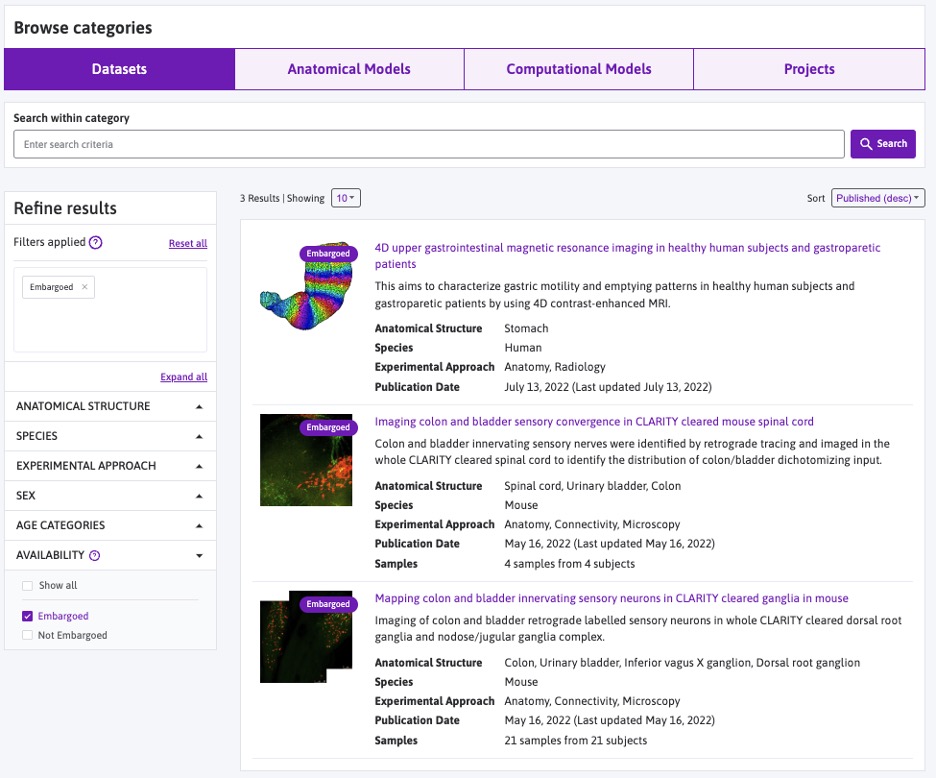Embargoed Datasets
What is embargo and what does it mean for datasets?
Embargo is the set amount of time period by which investigators can retain exclusive rights to their Dataset s while Publishing them to the SPARC Portal in a controlled way [cite].
SPARC’s embargo period can be up to 12 months, as set by the dataset owner during the SPARC Portal publication process. After the embargo period is over, datasets become available for public access.
Why have an embargo?
SPARC supports data sharing and access of resources made available through the SPARC Data and Resource Center (DRC) to other members of SPARC and to the entire scientific community. The foundation of this collaborative model is an opportunity for investigators to freely use these data to support discovery efforts, as well as data citation through recognition of the source of data and/or unpublished protocols.
The SPARC program requires that recipients of certain awards share their data with other SPARC funded investigators upon completion of milestones from which the data was generated (including pre-publication data). Access to data and resources submitted during the embargo period is intended to enhance collaboration and productivity of all SPARC awardees, thereby leveraging the impact of the entire program.
How does SPARC manage the embargo process?
The National Institutes of Health, through DAT-Core managed Pennsieve functionality on the SPARC Portal, will allow individuals to access confidential information only when the individual has certified their agreement to comply with the terms of the SPARC Embargoed Data Use Agreement (DUA) and the SPARC Material Sharing Policy.
The DUA is designed to legally protect investigators who are sharing pre-publication data. By signing the agreement, you agree not to unilaterally publish or publicly disclose others' embargoed data or use them for commercial purposes without a license.
Who has access to embargoed datasets?
During this embargo period, the public will only be able to view metadata about embargoed datasets on the SPARC Portal, as well as the date the datasets’ embargo period ends and is available publicly. Members of the public who would like access to a dataset during its embargo period can request access from the dataset’s corresponding author and sign the DUA through the SPARC Portal by the mechanism described below.
Will I still be able to publish on my datasets once they are publicly available? Do journals consider release of data and protocols to be a prior publication?
Once the data and protocol are made public after the embargo period, the authors will be able to publish papers using these data and protocol.
SPARC takes the position, consistent with stated policies on data sharing and preprint deposition of publishers and journals, that release of data through the SPARC Portal and deposition of associated protocols in Protocols.io does not preclude a researcher from publishing works that utilize or further describe either the data or the protocol.
Publishers and journals are actively behind data sharing and many are either requiring or recommending that data be made available in a public repository at time of publication. Authors are to include a data availability statement that includes the DOI or URL of the dataset deposited. Publishers and many journals have explicitly stated that deposition of a manuscript in a preprint service like biorXiv does not constitute prior publication. We agree with Protocols.io that making the protocol available through protocols.io ahead of publication is covered under that policy and will not interfere with submission of any articles utilizing such protocols.
The Pennseive data management platform and Protocols.io, used to prepare data for publication on the SPARC Portal, provide the functionality to assign independent DOIs to the dataset as a whole and its protocol. Assignment of a DOI is not dependent on the embargo.
How do I find embargoed datasets on the SPARC Portal?
Datasets under embargo are denoted by the “Embargoed” tag on the gallery image and can be found by checking the Find Data faceted browser category Availability to Embargoed.

How do I request access to an embargoed dataset?
Datasets under embargo are denoted by the “Embargoed” tag on the gallery image.
- Click on the Get Dataset button below the gallery image

- Sign In to the SPARC Portal. You will be brought from the Abstract tab of the Dataset Details page to the Files tab where you can find instructions on how to Sign In to the SPARC Portal to gain access to the Request Access button. More information on the SPARC Portal Login can be found here.

- Click on the Request Access button that is accessible after logging in

- Accept the NIH SPARC Embargoed Data Use Agreement via electronic click in the popup window.
By electronically clicking on the checkbox and the Sign and Submit button, you are accepting the terms of the NIH SPARC Embargo Data Use Agreement.
Clicking the Sign and Submit button, automatically sends an email requesting access on your behalf from Pennsieve to the Contact Author listed on the dataset's About tab.

- Email the Contact Author directly to provide them with more information about why you are interested in accessing this dataset during embargo. The request should describe all intended data uses, including the plan for analysis, overview of methods, and expected outcomes. The terms of use of the data must be mutually acceptable between you, the Data User, as the requestor and the Contact Author.
- The Contact Author will then review your request and either approve or deny it within the Permissions section of the embargoed dataset located on the Pennsieve data management platform.
Updated 6 months ago
